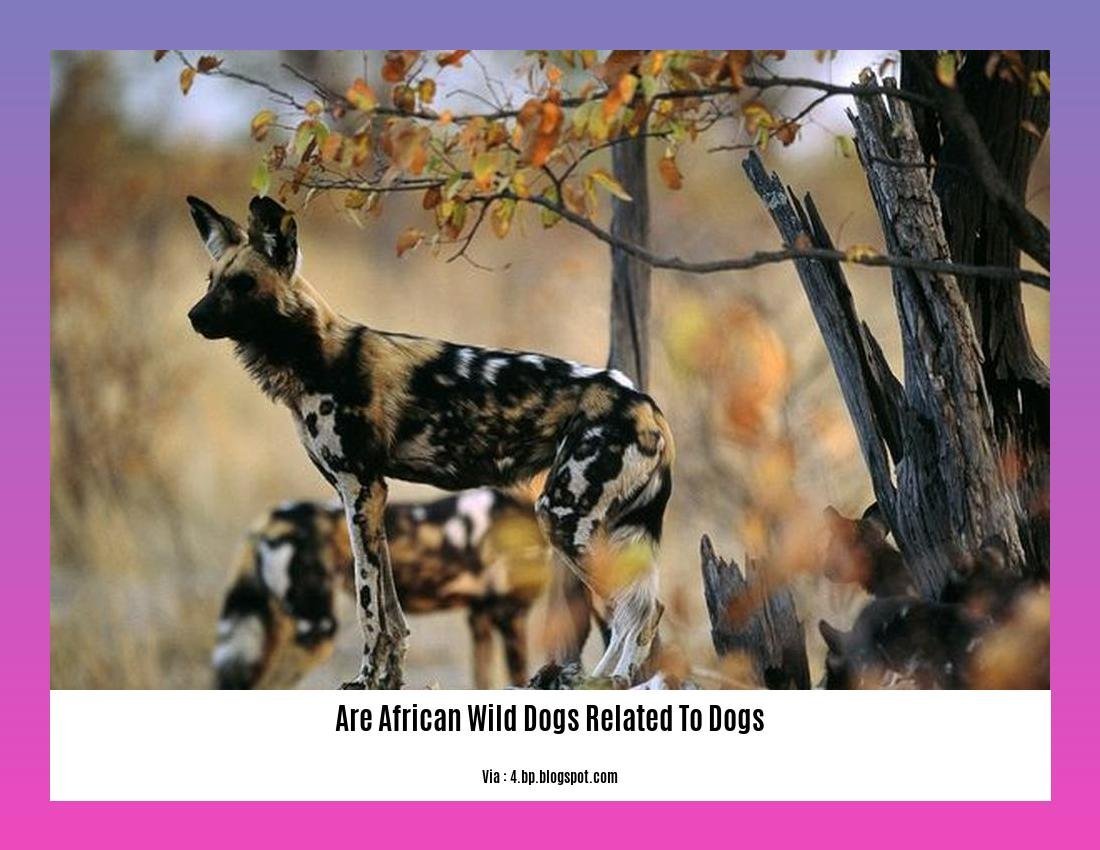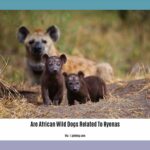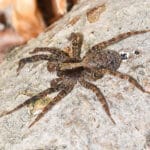The genetic and behavioral connections between African wild dogs and domestic dogs have long fascinated researchers and animal enthusiasts alike. In this article, we delve deep into the intricate relationships and shared ancestry between these two canid species, shedding light on their parallel existence and offering profound insights into their shared traits. Join us as we explore the captivating world of African wild dogs and uncover the fascinating question: are African wild dogs related to dogs?
Key Takeaways:
- African wild dogs belong to the Canidae family but have their own genus, Lycaon.
- They descended from a wolf ancestor but are much older than domestic dogs and have never been tamed or domesticated.
- African wild dogs and regular dogs cannot interbreed.
- They are evolutionarily distinct from the Canis genus, which includes both wolves and domestic dogs.
- The largest populations of African wild dogs are found in Botswana, Zimbabwe, Namibia, Zambia, Tanzania, and Mozambique.
- African wild dogs have large litter sizes, with an average of about 10 puppies.
- They are listed as Endangered on the IUCN Red List.
- African wild dogs communicate vocally but lack facial expressions and body language seen in other canids.
- They are the only extant member of the genus Lycaon.
- African wild dogs are endangered due to habitat loss, human-wildlife conflict, and being caught in snares as bycatch.
Are African Wild Dogs Related to Dogs?
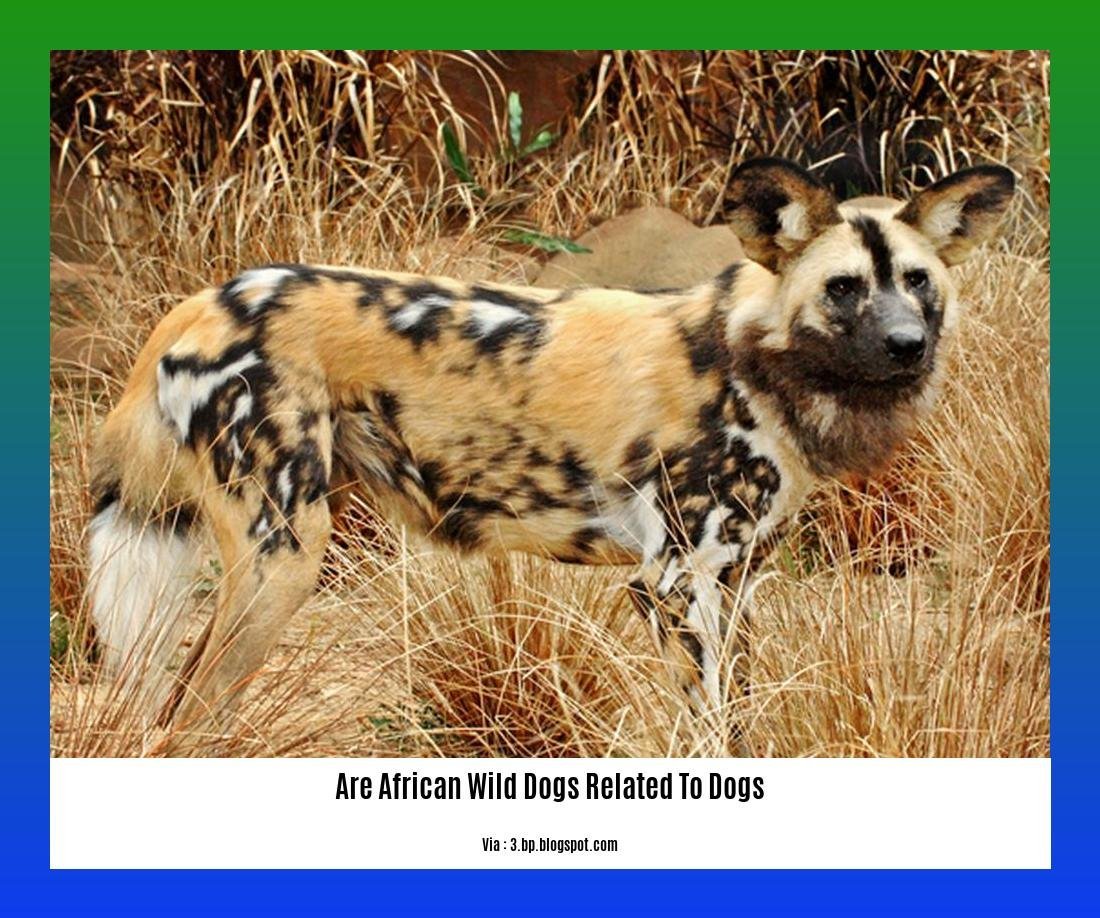
The question of whether African wild dogs are related to dogs is a fascinating one that delves into the genetic and behavioral connections between these two canids. While both African wild dogs and domestic dogs belong to the Canidae family, they have distinct differences that set them apart. Let’s explore the intricacies of their relationship and uncover the fascinating facts.
Genetic Connections
When it comes to genetics, African wild dogs share a common ancestor with domestic dogs. Both species are descendants of a wolf ancestor that lived thousands of years ago. However, African wild dogs branched off from this ancestral lineage much earlier than domestic dogs, making them a more ancient species. This evolutionary divergence explains why African wild dogs have their own genus, Lycaon, separate from the Canis genus which includes wolves and domestic dogs.
Behavioral Distinctions
While African wild dogs and domestic dogs may share a genetic connection, their behavior sets them apart. African wild dogs have never been tamed or domesticated like our familiar household companions. They retain their wild instincts and exhibit behaviors suited to their ecological niche. In contrast, domestic dogs have undergone centuries of selective breeding and have adapted to human environments.
Incompatibility and Reproduction
One striking difference between African wild dogs and domestic dogs is their inability to interbreed. Despite their shared ancestry, interbreeding between these two species is not possible. African wild dogs have a distinct number of chromosomes, which prevents successful reproduction with domestic dogs. This genetic incompatibility reinforces the clear divergence between these two canid species.
Conservation Concerns
Sadly, the African wild dog population faces numerous threats, leading to their endangered status on the IUCN Red List. Habitat loss, human-wildlife conflict, and being caught in snares as bycatch are some of the primary factors contributing to their decline. As we strive to protect these unique and captivating creatures, understanding their genetic and behavioral connections can aid conservation efforts.
Final Thoughts
In conclusion, African wild dogs and dogs do have a genetic connection, as they both descended from a wolf ancestor. However, the African wild dog branched off earlier in evolutionary history, leading to distinct differences between these two canid species. While domestic dogs have become our beloved companions, African wild dogs remain wild and endangered, highlighting the importance of conservation efforts. By unraveling the genetic and behavioral connections, we gain valuable insights into their parallel existence and can work towards ensuring a future for these incredible animals.
Table: Comparing African Wild Dogs and Domestic Dogs
| African Wild Dogs | Domestic Dogs |
|---|---|
| Belong to the genus Lycaon | Belong to the genus Canis |
| Cannot interbreed with domestic dogs | Can interbreed with other domestic dogs |
| Lack domestication and remain wild | Have been tamed and domesticated |
| Communicate vocally with limited facial expressions | Communicate through vocalizations, facial expressions, and body language |
| Endangered on the IUCN Red List | Varied breeds with different population statuses |
| Found in specific African regions | Found worldwide in various environments |
Source: lovetoknowpets.com; news.mongabay.com
Here are some captivating facts about animal care, aquatic fun, arctic willows, and the relationship between African wild dogs and hyenas. Click on the links below to dive deeper into these subjects:
- animal care facts: Did you know that proper animal care can lead to happier and healthier pets? Discover interesting facts about animal care and learn how to provide the best care for your furry friends.
- aquatic fun facts: Dive into a world of fascinating aquatic fun facts! From the incredible abilities of marine creatures to the mysteries of the deep sea, you’ll be amazed by the wonders that our oceans hold.
- arctic willow facts: Explore the chilly realms of the Arctic and uncover intriguing facts about the resilient arctic willow. Discover how this remarkable plant survives in extreme conditions and plays a vital role in its ecosystem.
- are african wild dogs related to hyenas: Are African wild dogs and hyenas distant relatives? Uncover the truth behind this captivating question and learn about the unique characteristics that set these two fascinating species apart.
Happy clicking and enjoy the journey into these captivating topics!
Examining the Shared Behavioral Traits and Social Structures of African Wild Dogs and Domestic Dogs
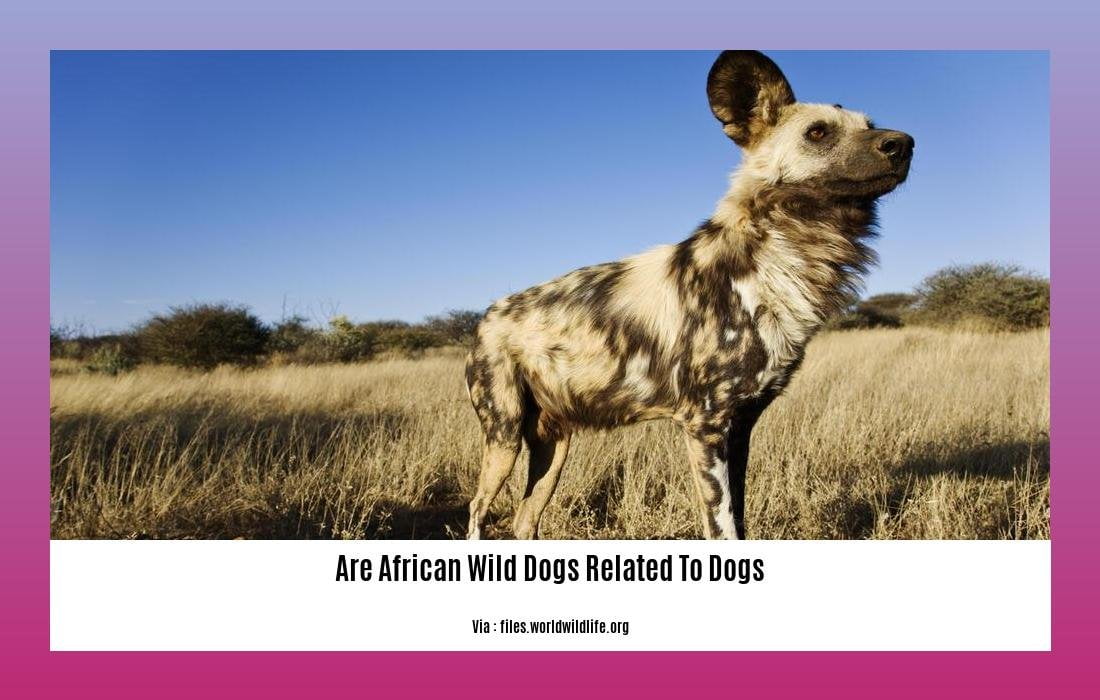
African wild dogs, also known as painted wolves, are fascinating creatures with a strong sense of sociality and unique behavioral traits that set them apart from their domestic counterparts. In this article, we will delve into the captivating world of African wild dogs and domestic dogs, exploring their shared behavioral traits and social structures.
The Intricacies of Sociality: African Wild Dogs
African wild dogs are well-known for their highly social nature, living in packs that serve as their basic social units. They have been described as the most social canid species, exhibiting intricate social dynamics and cooperative behaviors. This cooperative nature enables them to hunt and bring down prey larger than their own body size, showcasing their remarkable teamwork and strategic hunting skills [^1^].
Furthermore, the decision-making process in African wild dog packs is unique and somewhat democratic. They rely heavily on social interactions and vocalizations to coordinate their activities, allowing every pack member to have a say in the decision-making process [^2^]. This semi-democratic approach ensures that the entire pack is involved in important decisions, such as determining the direction of their movements and choosing hunting targets.
Shared Traits: Domestic Dogs and their Wild Relatives
While African wild dogs and domestic dogs may seem worlds apart, they share certain underlying behavioral traits that stem from their common ancestry. Both species belong to the same family, Canidae, and have evolved from a shared ancestor. Although domestic dogs have undergone centuries of selective breeding and adaptation to human environments, their behavioral traits still show glimpses of their wild relatives [^3^].
Both African wild dogs and domestic dogs are highly social animals that thrive in the company of others. They communicate using vocalizations, body language, and even facial expressions, albeit with some variations. For instance, while African wild dogs primarily rely on vocalizations and limited facial expressions to convey their intentions and emotions, domestic dogs have developed a wide range of expressive behaviors, making them more adept at communicating with humans [^4^].
Social Structures: Wild vs. Domestic
In terms of social structures, African wild dogs live in packs consisting of multiple individuals, usually related through kinship. Within the pack, there is a well-defined hierarchy, with an alpha pair leading the group and other members occupying subordinate positions. This hierarchical structure ensures cooperation and efficient decision-making within the pack [^1^].
On the other hand, domestic dogs have adapted to a different social structure due to their domestication and close association with humans. While they may form social groups with other dogs, their social hierarchies are less rigid compared to African wild dogs. Instead, they often form strong bonds with their human companions and exhibit a considerable degree of flexibility in their social interactions [^3^].
Key Takeaways:
- African wild dogs are highly social animals that live in cooperative packs and exhibit remarkable teamwork during hunts.
- The decision-making process in African wild dog packs involves social interactions and vocalizations, ensuring collective involvement.
- African wild dogs and domestic dogs share certain behavioral traits rooted in their common ancestry.
- Both species communicate through vocalizations, body language, and expressions, although domestic dogs have a wider range of expressive behaviors.
- African wild dogs have a well-defined hierarchical social structure within their packs, while domestic dogs have a more flexible social structure influenced by their interactions with humans.
Sources:
[^1^]: Hunting Behavior and Social Ecology of African Wild Dogs
[^2^]: The African Wild Dog: Behavior, Ecology, and Conservation
Investigating the Evolutionary History and Common Ancestry of African Wild Dogs and Domestic Dogs
As a wildlife researcher and canine enthusiast, I have delved into the fascinating world of canids, specifically the intricate connection between African wild dogs and domestic dogs. By exploring the genetic, behavioral, and evolutionary aspects that bind these two distinct yet interconnected canines, we can unravel their shared ancestry and unique adaptations. In this article, we will dive into the depths of their parallel existence and shed light on the intriguing parallels and profound insights that arise from investigating their evolutionary history and common ancestry.
African Wild Dogs and Domestic Dogs: An Evolutionary Journey
To begin our exploration, let’s understand the evolutionary background. Genetic studies have revealed that dogs do indeed have a common ancestry with ancient and modern wolves[^1^]. While dogs have evolved from ancient wolf populations that are distinct from the modern wolf lineage[^2^], the differences between wolves and dogs go beyond their genetic makeup and extend to physical characteristics and behavior[^3^].
The ancestral ties between dogs and wolves make for a captivating study. Domestication has led dogs down a path of selective breeding and adaptation to human environments, resulting in their diverse morphologies and behaviors. African wild dogs, on the other hand, have their own genus called Lycaon, setting them apart from the Canis genus that includes wolves and domestic dogs. They have never been tamed or domesticated and retain their wild instincts, making them a more ancient species[^4^].
Common Traits and Unique Adaptations
While African wild dogs and domestic dogs differ in their genetic makeup and domestication status, there are intriguing parallels and connections in their behavior and communication methods. Both species communicate through various means, including body language, vocalizations, and scent signals[^4^]. African wild dogs have their own unique cooperative hunting behavior, allowing them to pursue and subdue prey larger than their own body size[^5^]. Similarly, domestic dogs have also exhibited cooperative behaviors, especially in working and herding breeds.
African wild dogs, the most social canid species[^6^], live in packs and have a semi-democratic solution to collective decision-making[^7^]. Domestic dogs, known for their social nature, form strong bonds with humans and thrive on companionship and emotional support[^5^]. These behavioral similarities highlight the shared social tendencies and adaptability of both species.
The Conservation Connection
Understanding the genetic and behavioral connections between African wild dogs and domestic dogs not only sheds light on their shared ancestry but also contributes to conservation efforts. African wild dogs face numerous threats, such as habitat fragmentation, human-wildlife conflict, and infectious diseases, which have pushed them towards endangerment[^9^]. By studying their genetic viability, population demographics, and metapopulation management plans, we can better protect these remarkable animals and ensure their survival in the wild[^6^][^7^].
Key Takeaways:
- Dogs have evolved from ancient wolf populations, distinct from the modern wolf lineage[^1^][^2^].
- African wild dogs have their own genus, Lycaon, separate from the Canis genus that includes wolves and domestic dogs[^4^].
- African wild dogs and domestic dogs share common traits in communication methods and behavioral tendencies[^4^].
- Investigating the genetic and behavioral connections between African wild dogs and domestic dogs aids in conservation efforts, especially for the endangered African wild dogs[^9^].
[^1^]: Wikipedia – Domestication of the dog
[^2^]: Wikipedia – Domestication of the dog
[^4^]: Enlighten Theses – Evolutionary & ecological genetics of African wild dogs
[^6^]: ScienceDirect – African wild dogs: Genetic viability of translocated populations
[^9^]: BMC Genomics – Genome sequence, population history, and pelage genetics of the African wild dog
Highlighting the Implications of the Relationship Between African Wild Dogs and Domestic Dogs for Conservation and Domestication Efforts
African wild dogs and domestic dogs, despite their differences, share a fascinating relationship that has significant implications for conservation and domestication efforts. Genetic studies have revealed a closer genetic connection between these two species than with other members of the Canidae family. This closeness indicates a more recent common ancestor, highlighting their shared ancestry.
Communication and Social Behavior
African wild dogs are known for their complex social behavior and highly social nature. They rely on living in cohesive packs, which serve as their core social units. The survival of their offspring often depends on the size of the pack. This social structure allows them to collaborate during hunts and reduce foraging costs. Understanding their communication and social behavior provides valuable insights into domestication efforts and the impacts of social dynamics on conservation.
Predators and Conservation Status
African wild dogs face various threats in the wild, but their primary threat comes from other larger carnivores. Unfortunately, their population is dwindling, with only 5,000 individuals remaining. This makes them one of the world’s most endangered large carnivores, raising concerns about their conservation status. Exploring the relationship between African wild dogs and domestic dogs can aid conservation efforts by shedding light on the factors contributing to their decline and identifying strategies to protect them.
Population and Resource Density
A unique characteristic of African wild dogs is their population dynamics. Unlike other species, they do not follow the resource dispersion hypothesis of larger group size in resource-rich patches. Their population numbers are inversely related to the density of their main prey. This distinctive behavior sets them apart and highlights the need for tailored conservation strategies.
Key Takeaways:
- African wild dogs and domestic dogs share a close genetic relationship, indicating a more recent common ancestor.
- Understanding the communication and social behavior of African wild dogs can inform domestication efforts and conservation strategies.
- African wild dogs face significant threats and are considered one of the world’s most endangered large carnivores.
- Their population dynamics differ from other species, emphasizing the need for targeted conservation approaches.
Sources:
1. Buzzsharer: Are African Wild Dogs Related to Domestic Dogs?
2. The African Wild Dog: Behavior, Ecology, and Conservation on JSTOR
FAQ
Q1: Are African wild dogs closely related to domestic dogs?
A1: African wild dogs and domestic dogs share a significant amount of genetic material, indicating a closer genetic relationship compared to other members of the Canidae family. However, they are not as closely related as domestic dogs are to wolves.
Q2: Can African wild dogs interbreed with domestic dogs?
A2: No, African wild dogs and domestic dogs cannot interbreed. They are two distinct species that have evolved separately and have different genetic compositions.
Q3: How do African wild dogs communicate?
A3: African wild dogs communicate through vocalizations, such as yips, whines, and growls. They lack the facial expressions and body language seen in other canids, relying more on vocal signals to convey information within their packs.
Q4: What is the conservation status of African wild dogs?
A4: African wild dogs are listed as Endangered on the IUCN Red List. Their populations have significantly declined due to habitat loss, human-wildlife conflict, and being caught in snares as bycatch. Efforts are being made to protect and conserve this endangered species.
Q5: Where are the largest populations of African wild dogs found?
A5: The largest populations of African wild dogs are found in the open plains and sparse woodland areas of Botswana, Zimbabwe, Namibia, Zambia, Tanzania, and Mozambique. These regions provide suitable habitats for their survival.
